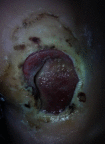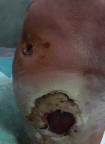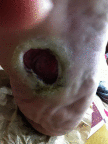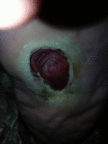Impact of olive oil and honey on healing of diabetic foot: a randomized controlled trial
- PMID: 31190942
- PMCID: PMC6516048
- DOI: 10.2147/CCID.S198577
Impact of olive oil and honey on healing of diabetic foot: a randomized controlled trial
Abstract
Background: This study aimed 1) to examine the impact of honey on diabetic foot; 2) to examine the effect of olive oil on diabetic foot; and 3) to compare the impact of honey and olive oil in the healing of diabetic foot. Methods: In this randomized controlled trial, 45 patients took part. Patients were randomly assigned to three groups. In the honey group, the wound was dressed using gauzes with honey daily for 1 month. In the olive oil group, the wound was dressed using gauzes with olive oil (4 mL) daily for 1 month. Patients in the control group received usual dressing. Wounds were assessed before and after intervention using the Wagner scoring system and the checklist of diabetic foot healing (where a higher score indicates better wound healing). Results: Demographic characteristics of patients in the three groups were similar. Mean scores of tissue around the wound, wound grade, wound drainage, and wound healing were similar before intervention in all three groups. After intervention, means score of tissue around the wound, wound grade, wound drainage, and wound healing were significantly higher in patients in the honey and olive oil groups compared to patients in the control group. Conclusion: The results of this study reveal that honey is as effective as olive oil in the treatment of diabetic foot. Given the few studies on this topic, further investigation is needed.
Keywords: therapeutic use; foot ulcer; honey; olive oil.
Conflict of interest statement
The authors report no conflicts of interest in this work.
Figures







Similar articles
-
The effect of topical olive oil dressing on the healing of grade 1 and 2 diabetic foot ulcers: An assessor-blind randomized controlled trial in type 2 diabetes patients.Diabetes Metab Syndr. 2022 Dec;16(12):102678. doi: 10.1016/j.dsx.2022.102678. Epub 2022 Nov 23. Diabetes Metab Syndr. 2022. PMID: 36459908 Clinical Trial.
-
The effect of topical olive oil on the healing of foot ulcer in patients with type 2 diabetes: a double-blind randomized clinical trial study in Iran.J Diabetes Metab Disord. 2015 Apr 29;14:38. doi: 10.1186/s40200-015-0167-9. eCollection 2015. J Diabetes Metab Disord. 2015. PMID: 25969821 Free PMC article.
-
Outcomes of a honey and olive oil-based dressing material on wounds of women that have had a caesarean section in south-western Uganda.Int Wound J. 2024 Sep;21(9):e70038. doi: 10.1111/iwj.70038. Int Wound J. 2024. PMID: 39211979 Free PMC article.
-
Effectiveness of honey dressing in the treatment of diabetic foot ulcers: A systematic review and meta-analysis.Complement Ther Clin Pract. 2019 Feb;34:123-131. doi: 10.1016/j.ctcp.2018.09.004. Epub 2018 Sep 21. Complement Ther Clin Pract. 2019. PMID: 30712715
-
Use of honey in diabetic foot ulcer: Systematic review and meta-analysis.J Tissue Viability. 2023 May;32(2):270-278. doi: 10.1016/j.jtv.2023.03.002. Epub 2023 Mar 23. J Tissue Viability. 2023. PMID: 37032304
Cited by
-
Honey in Alleviating Severe Oral Mucositis Among Head and Neck Cancer Patients Undergoing Radiation Therapy.In Vivo. 2024 May-Jun;38(3):1397-1404. doi: 10.21873/invivo.13581. In Vivo. 2024. PMID: 38688612 Free PMC article.
-
Short-term effect of dressing with Dermaheal ointment in the treatment of diabetic foot ulcer: A double-blinded randomized controlled clinical trial.Health Sci Rep. 2024 Feb 13;7(2):e1868. doi: 10.1002/hsr2.1868. eCollection 2024 Feb. Health Sci Rep. 2024. PMID: 38357487 Free PMC article.
-
Comparative Evaluation of the Effect of Aloe Vera Gel, Olive Oil, and Compound Aloe Vera Gel-Olive Oil on Prevention of Pressure Ulcer: A Randomized Controlled Trial.Adv Biomed Res. 2022 Jan 31;11:6. doi: 10.4103/abr.abr_121_21. eCollection 2022. Adv Biomed Res. 2022. PMID: 35284353 Free PMC article.
-
Anti-Inflammatory and Restorative Effects of Olives in Topical Application.Dermatol Res Pract. 2021 Jun 26;2021:9927976. doi: 10.1155/2021/9927976. eCollection 2021. Dermatol Res Pract. 2021. PMID: 34257643 Free PMC article. Review.
-
Efficacy of the combination of Chinese herbal medicine and negative pressure wound therapy in the treatment of patients with diabetic foot ulcer: A meta-analysis.Int Wound J. 2024 Apr;21(4):e14536. doi: 10.1111/iwj.14536. Epub 2023 Dec 8. Int Wound J. 2024. Retraction in: Int Wound J. 2025 Mar;22(3):e70327. doi: 10.1111/iwj.70327. PMID: 38069543 Free PMC article. Retracted.
References
-
- Leone S, Pascale R, Vitale M, Esposito S. Epidemiology of diabetic foot. Infez Med. 2012;20(1):8–13. - PubMed
-
- Nasiri M, Fayazi S, Jahani S, Yazdanpanah L, MH Haghighizadeh. The effect of topical olive oil on the healing of foot ulcer in patients with type 2 diabetes: a double-blind randomized clinical trial study in Iran. J Diabetes Metab Disord. 2015;14:38. doi:10.1186/s40200-015-0167-9 - DOI - PMC - PubMed
LinkOut - more resources
Full Text Sources

